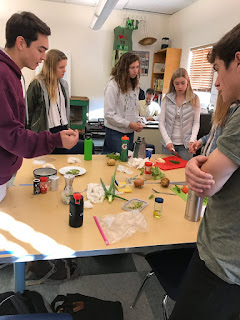Wednesday, December 20, 2017
Seedling starts
Marin Co. Farmer's Market
Josh
Carbon Farming
Julian C
Looking back: The week of November 13th
Wednesday, December 13, 2017
Companion Report Reflection and Farm Work on Physical State
Tuesday, December 12, 2017
More on cooking
Iron Chef Competition #2:On Monday my fellow classmates and I were reminded about our second Iron Chef Competition coming back from the break, but we were also treated to a surprise. Mr. Stewart added that we must incorporate basil in our recipes.My group was stumped for a minute as we began to wonder if we could continue with the plan of making pasta with pesto from the abundant fava bean leaves in the RHS Farm. We had decided that the pesto recipe was what we wanted to make because a member in our bed group had made it for her Farm to Fork assignment and told us that it was simple to make and didn't turn out terrible. It was only further agreed when we noticed that row E7 had an ample amount of fava bean leaves. We didn't want to take it from our own bed in concern for the continual survival of the crop. We amended the recipe to meet the challenge by deciding that we would split the fava bean leaves and basil amount equally to make a fava bean leaf and basil pesto. In addition, we also grouped up with bed A12 and decided upon also making kale chips and lemon verbena and mint tea, something that the individuals from that bed group had also made before.There was a slight concern that we wouldn't have enough time to make the small meal that we had decided upon but I am confident that our decision was best.
Carmen Noyola


Market Day
Looking back: New Iron Chef Challenge and Market Day!
Thursday, December 7, 2017
Switching Seasons!
This week in Sustainable Agriculture, change was in the chilly December air! As the seasons begin to change, students are beginning to plan and prepare for the winter ahead. We kicked off the week with a focus on our one-beds: what to harvest, what to plant, and what plants we plan to transfer, all the while considering which ones are able to withstand the cold. My group, bed A4, found that legumes and onions thrive this time of year! After some research, consultation of our trusty textbooks, and some quick calculations, we all developed solid plans for conquering the winter season, along with estimates of how our planting will contribute to our overall harvest goals. As Wednesday rolled around, we bundled up and headed out to the farm bright and early to prep the farm for the upcoming months. Starting at a fresh 8 AM, respective groups headed out to do their part, and there were many things that needed to be attended to. Many of the pathways had turned to puddles, and we reinforced our pathways with cardboard and hay to hopefully maintain solid ground through the rainy days ahead. Additionally, we weeded our one beds, watered seedlings in the hoop house, and my personal favorite, planted winter seeds into flats so they will be ready to transfer by January! Groups planted bell beans, radishes, and made sure to steer clear of warm-weather plants like carrots. The flats were transferred to the classroom, where they will remain until they are big, strong, and ready to thrive in our student beds throughout the winter season, and hopefully produce a bountiful spring harvest!
--Lauren Bell



